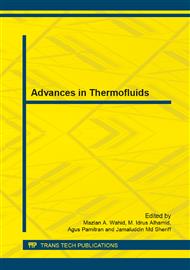[1]
Z. Yuan and K. E. Herold, Thermodynamic properties of aqueous lithium bromide using a multiproperty free energy correlation, HVAC and R Research, vol. 11, pp.377-393, (2005).
DOI: 10.1080/10789669.2005.10391144
Google Scholar
[2]
L. A. McNeely, Thermodynamic properties of aqueous solutions of lithium bromide, ASHRAE Trans vol. 85, pp.413-434, (1979).
Google Scholar
[3]
W. Wagner, J. R. Cooper, A. Dittmann, J. Kijima, H. J. Kretzschmar, A. Kruse, R. Mareš, K. Oguchi, H. Sato, I. Stöcker, O. Šifner, Y. Takaishi, I. Tanishita, J. Trübenbach, and T. Willkommen, The IAPWS industrial formulation 1997 for the thermodynamic properties of water and steam, Journal of Engineering for Gas Turbines and Power, vol. 122, pp.150-180, (2000).
DOI: 10.1115/1.483186
Google Scholar
[4]
IAPWS. Release on the IAPWS Formulation 2008 for the Viscosity of Ordinary Water Substance [Online]. Available: http: /www. iapws. org.
Google Scholar
[5]
IAPWS. Release on the IAPWS Formulation 2011 for the Thermodynamic Conductivity of Ordinar Water Substance [Online]. Available: http: /www. iapws. org.
DOI: 10.1007/978-3-662-53219-5_3
Google Scholar
[6]
M. J. Kirby and H. Perez-Blanco, Design model for horizontal tube water/lithium bromide absorbers, 1994, pp.1-10.
Google Scholar
[7]
H.I. Abu-Mulaweh, D.W. Mueller, B. Wegmann, K. Speith, and B. Beohne, Design of a Bubble Pump Cooling System Demonstration Unit, Int. J. of Thermal & Environmental Engineering, vol. 2, pp.1-8, (2011).
DOI: 10.5383/ijtee.02.01.001
Google Scholar
[8]
H. T. Chua, H. K. Toh, A. Malek, K. C. Ng, and K. Srinivasan, A general thermodynamic framework for understanding the behaviour of absorption chillers, International Journal of Refrigeration, vol. 23, pp.491-507, (2000).
DOI: 10.1016/s0140-7007(99)00077-8
Google Scholar
[9]
C. W. Park, S. S. Kim, H. C. Cho, and Y. T. Kang, Experimental correlation of falling film absorption heat transfer in micro-scale hatched tubes, International Journal of Refrigeration, vol. 26, pp.758-763, (2003).
DOI: 10.1016/s0140-7007(03)00069-0
Google Scholar
[10]
W. W. S. Charters, V. R. Megler, W. D. Chen, and Y. F. Wang, Atmospheric and sub-atmospheric boiling of H2O and LiBr/H2O solutions, International Journal of Refrigeration, vol. 5, pp.107-114, (1982).
DOI: 10.1016/0140-7007(82)90085-8
Google Scholar
[11]
M. W. Shahzad, A. Myat, W. G. Chun, and K. C. Ng, Bubble-assisted film evaporation correlation for saline water at sub-atmospheric pressures in horizontal-tube evaporator, Applied Thermal Engineering, vol. 50, pp.670-676, (2013).
DOI: 10.1016/j.applthermaleng.2012.07.003
Google Scholar


